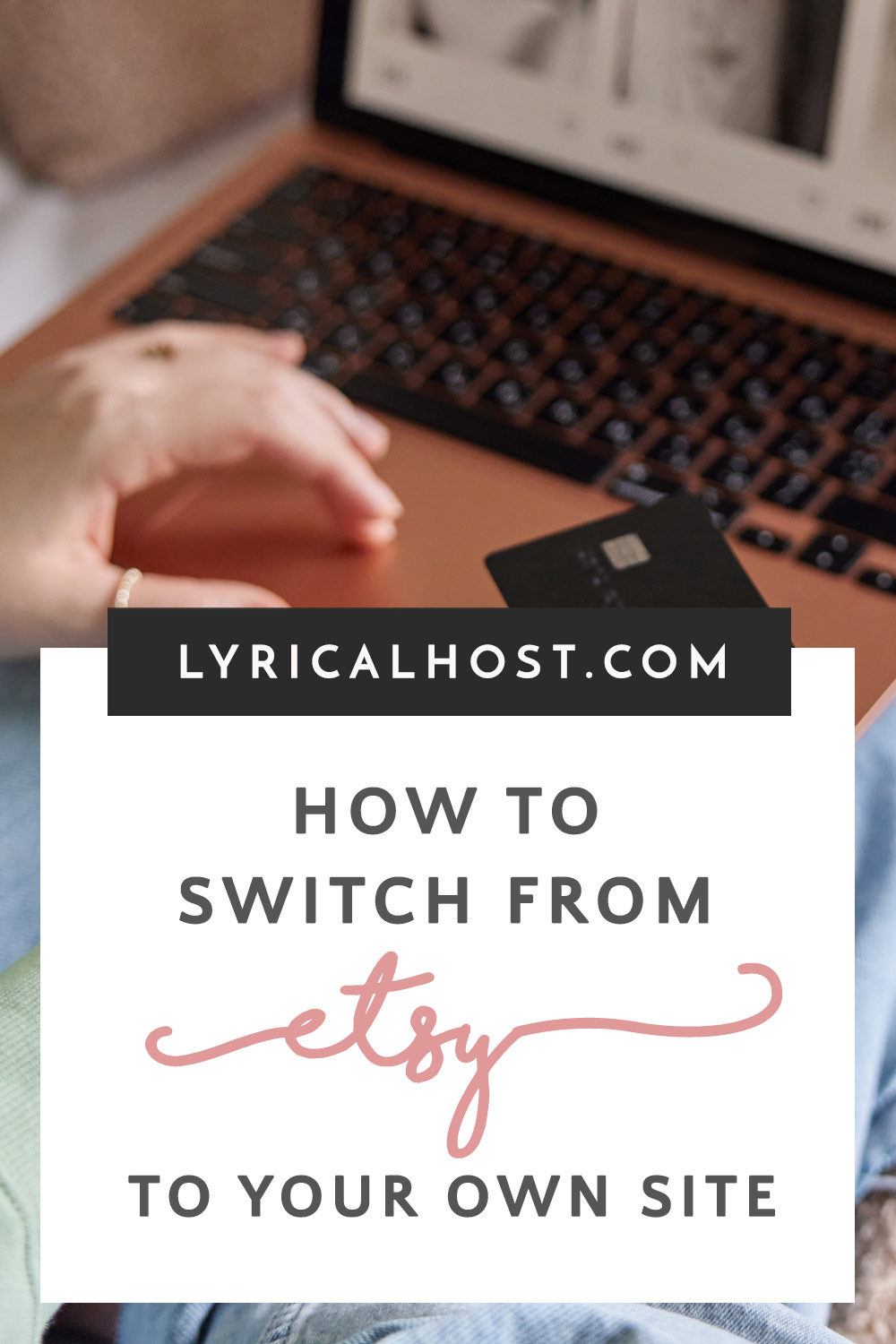Etsy can be great for driving traffic and brand awareness in the early stages of your business, but there are tons of benefits to having your own website in the long run.
Read on to find out more about those, plus all our tips and tricks for making the transition.
Currently reading: How To Transition From Etsy To Selling From Your Own Website Click To Tweet
This post is divided into separate sections:
- The benefits of your own website over Etsy
- Making the transition
- Using your Etsy store as a lead generator
- Building awareness of your website
- Other ways to get traffic to (and sales from) your website
- Things to remember
Jump to the sections you’re interested in using the links above, or just read straight through – it’s up to you.

Why encourage people to buy from your own website rather than your Etsy?
Save money on fees – This is the main reason many Etsy sellers look to transition to their own website. Once you have your hosting and WooCommerce set up (our team can help you with this – just raise a support ticket!), you can list your items without a per-product fee.
Beyond your hosting, and one or two paid plugins you may need (for example to handle EU VAT), the costs are fixed other than your payment processor fees (e.g. Stripe or PayPal). It’s important to look at all your options beforehand to calculate how much it will cost you. A good host will allow for ecommerce functionality (such as WooCommerce) even on their cheapest plan.
If you’re just starting out, don’t have tons of products/sales, or you only sell digital products, you may not even want to install WooCommerce to begin with. You could use a PayPal button on your page or embed through one of these services: 14 ways to sell digital products from your website [link]
This allows you to plan ahead better (no surprise increases, or increases in multiple places hitting you at once) and gives you the choice of passing the savings on to your customers or keeping more profit.
More control over how you do business – Having your own website means you have all the say on things like exactly how you run sales, refunds, when you ship items, and so on. You can offer checkout bumps, suggest more products, and do free or discounted products and bundles based on what someone buys. As long as you’re not breaking the law (for example by refusing to refund non-personalized products), you’re good. If you sell in person, you can also give your customers the option of click and collect or paying on pickup.
Importantly, you’re not tied to Etsy if they decide to change their terms to ones that don’t work for you, shut your shop, put your account or payments on hold, increase costs, try to control how/when you ship, etc. – all of which could shut your business down overnight.
Competitors aren’t being recommended to your customers – Etsy is forever showing ads of competitors’ products, similar products by other sellers, and displaying your products in the context of lots of other sellers’ goods. This can be a big distraction, and also means your products can in some cases be harder to find, or your customer ends up buying from someone else (either accidentally or because another seller has undercut you). On your own website, there’s no distractions and no confusion.
More control over your look and feel – You can design your website and product pages so they look exactly how you want, which means you can experiment with different looks and styles to see what converts better. This is even more useful for seasonal changes and sales, and for drawing your customers’ attention to what’s new.
It also gives you more options for promoting particular products or categories of products, highlighting sales, providing information about your products and business to your customers in a fully-formatted way that’s clear but not dominating.
Control review display and location – Etsy reviews are contained within Etsy, while Google and Trustpilot review ratings appear in search results all over the web, plus are easier for people to find if they’re specifically searching your site + reviews. They’re often also more user friendly, and can be embedded or copied and pasted to your website wherever you prefer. If people email you with feedback, you don’t have to rely on them to go and post an Etsy review – you can ask their permission to use it as a testimonial.
You can also embed non-traditional reviews, for example you could add tweets or Instagram posts where people have referenced your products; Instagram slideshows as social proof can be very effective.
Google rankings – Appearing in the top search engine results can be much more difficult with an Etsy shop compared to your own website, plus you have very little control over many of the things that can improve your rankings with Google. As Etsy SEO works differently and has different algorithms it can lead to conflicting situations where you’re forced to choose one over the other.
Selling your business – As Etsy terms don’t allow for shops to be sold, having your own independent store means you can build an asset that you can sell or pass on in the future. The value of your business is also increased through owning assets such as your domain name, having Google Analytics website data, and so on, which will also make buyers feel more confident in purchasing your business.

Making the transition from Etsy to your own website using Woocommerce
You may not want to move fully away from Etsy until you’ve tested the waters, and your transition will likely be gradual. Or in the long run, you may end up wanting to have both options for different reasons. Regardless, the goal is still to maximize the profit you’re walking away with, so there are a bunch of different routes you can go down.
Having both your own website and an Etsy store opens up your options far more than an Etsy store alone. To get started, search for your domain name and add a Tiny hosting plan to your cart, and WordPress will automatically be set up for you when you check out. If you haven’t used WordPress before, drop us an email at sales@lyricalhost.com or message our Facebook page at facebook.com/lyricalhost and we’ll give you demo details so you can play around and see what you think. We also have WordPress video tutorials available if you want to check those out.
When you’re picking a website URL (aka a domain name), make sure it’s memorable, easy to spell, and passes the “radio test” (i.e. if you say it out loud people would be able to write/type it accurately first time – it’s easy to hear, comprehend, and spell). For more tips on what makes a good name, download our free domain names guide (no sign up required).
After you’ve signed up, create a support ticket with our team (following the instructions in your welcome email/our getting started page) and they’ll be able to help you get set up with Woocommerce (a free store plugin that has paid add-ons if you need them). This includes installing the plugin, helping you with settings, and pointing you in the right direction for you to add pages and products to your website.
Once you’ve got the basics set up, there are also several Etsy WordPress plugins available, including ones that let you embed your store and ones that help you sync your stock (and so on) between the two platforms, so you don’t have to update both manually. From your WordPress Dashboard you can search for Etsy plugins to install and activate to see what you think.
Side note: If you only sell digital products, Easy Digital Downloads is also worth a look. Similarly to Woocommerce, it’s a free plugin with paid add-ons.
Using your Etsy store as a lead generator for your website
The thing most people are concerned about is how they’re going to get visitors to their own website if they can’t rely on Etsy traffic, which is definitely a top priority and something to consider before, during and after creating your own website.
Before you launch, strengthen and be more proactive in your relationships with other Etsy sellers, especially ones who have transitioned/are transitioning to their own websites. The right people can be the best launch buddies to help support you, and you can support them by sharing and engaging on social media – hopefully they’ll return the favor!
When you’re at the initial transition stage, shift your mindset and strategy to seeing Etsy as a lead generator rather than running your whole business. That means you’re taking advantage of Etsy traffic but minimizing your costs there, and moving away from being fully reliant on Etsy for your business.
Side note: If you’ve not seen Etsy traffic and you don’t get any sales from being there, you likely don’t need to be concerned about this as you’re not losing anything; the usual traffic strategies we cover below will still work for you, you just don’t need to worry about the Etsy side of things.
Etsy is very strict on how you can promote your own website in your product listings and on your Etsy store, and it’s best to be super cautious as you don’t want to be mistakenly flagged by an automated rule or change to policies. (A good reason why you want to have more control over your own business!). Etsy has a community thread and documentation on what you are and aren’t allowed to say, but these rules may be subject to change.
You aren’t allowed to tell people to buy from your website anywhere on Etsy, or offer incentives for them to do so (including product descriptions, shop info, and via messages). However, you can potentially include your website on your about page or FAQs page – just don’t actively direct buyers to it.
As this isn’t ideal for getting traffic to your website, you’ll want to look at different strategies for spreading the word about it, and creating compelling reasons for people to buy from your website over your Etsy store, which we cover in the next two sections of this blog post.
Before we get to that though, the first step is to review your Etsy store and consider the context of your website. As Etsy is becoming your lead generator rather than your entire business, you’re looking to minimize costs and make your website more attractive to buy from. Take a look at your current products and see how you can rework things; for example, you could sell multi-quantity listing items from your website instead, since Etsy charges you a listing fee for each variation sold. Private/custom listings could be offered via your website so you aren’t paying listing fees, plus you’re saving the time on creating a product listing as you just need a payment link for your buyer.
As Etsy transaction fees are a significant percentage of your orders, it often works out best to have lower value products on your Etsy, and higher value products on your website. For example, you could have a single item listing on your Etsy, but a bundle of three or five as one listing on your website. That way the higher cart value will be on your website orders, where you won’t be paying any Etsy transaction fees, increasing your profit by (at the time of writing this post, but it may increase in future) 6.5% per order.
The next thing is to (re)visit your sales funnel. This is basically the process that people go through from hearing about you, to buying from you. You don’t need any fancy software to create or review your funnels, you just need to test and see what works for you. For example, your funnel may look like:
Person sees your Instagram post > Subscribes to your email list (opts-in for a free recipe template) > Sees an email about a sale you have on more templates > Buys your templates.
There are many, many different options and pathways you can set up, you’re definitely not limited to just Instagram and email. It’s all about exploring different things and seeing what works for you and your audience. Using your website data (e.g. Google Analytics), you can look at how people have reached your site and what the most common referral sources are that lead to conversions for you. You can also look at where people drop off in your flow (for example, if they abandon their cart at checkout or close the tab on your product listing page) and make changes or run tests or offer other incentives accordingly. You can also ask customers where they heard about you at the point of purchase, if you don’t want to dig through analytics.

Building awareness of your website
Once you have your website set up – and ideally a launch party under your belt! – it’s time to consider ongoing strategies of building awareness.
Tell everyone, and keep telling them
Even though you may feel you’ve mentioned your website a million times already, and it’s taken over your life for a while, there will always be someone who hasn’t heard about it yet. So tell people, a lot, and keep telling them. Don’t just say the same thing on repeat though – think of different angles. For example, you could talk about deciding on a name and branding, what’s new and different, a behind the scenes of how you found the process, what you’d do differently, what your schedule/process looks like now, what things you didn’t expect to happen along the way, what launch deals you’re running, what website exclusives you’re doing, and so on.
You can also future rebrands, relevant seasonal elements, general updates, new blog posts, new services, loyalty schemes, refer a friend bonuses and so on as future reasons to talk about your website. Some people also redesign their front page seasonally and share it on social media or with their email subscribers.
Capture people searching Google for your Etsy shop
Make sure you mention your Etsy shop name on your website, so people searching Google for your Etsy shop also see your website pop up in the list of results. This could be on your FAQs page (e.g. “Are you also X on Etsy?” “Do you also have an Etsy shop?” “Where should I buy from you?” “Why do you have two shops?” etc.). It also means that people are clear that you’re the same entity and someone hasn’t copied you! If you’re feeling bold, you could even include your Etsy shop title in your page titles; although that could backfire if people leave your website to go to your Etsy! A similar, safer option would be to have a banner or short text box on your website explaining you’ve moved from Etsy.
Don’t forget to update all your social media, everywhere
Have your main website address featured on all your social media channels. This is an obvious one, but some people just don’t get around to updating their URLs, especially in the various different places across all the social networks. Make a big list, and even update channels you don’t use any more, just in case. And don’t forget bio descriptions, as well as URL fields!
Visually include your website address in your social media content
This could look like having your URL as a neon sign in some of your backgrounds, using wall decals, creating pegboard signs, wearing apparel with your website name, or having customised mats, desk pads, or even table stickers/vinyl if you do overhead videos or flatlay photos for things like tutorials or packing videos. (This is also an advantage for brand awareness if someone is coming across your content randomly as it’s more memorable/obvious. It also means that if a big channel or brand takes your content without permission, it will always be traceable back to you and is much harder to remove than a standard watermark).
Brand your packaging
Use a custom stamp, stickers or tissue paper with your website name for your packaging. Include a card with your details. Something that also provides a function that people can keep could be an option for you, e.g. a small fridge magnet with your website name subtly on it somewhere, or a nice card/postcard where the focus is primarily on the design or quote, and the website URL/business promo is a subtle second.
Have Etsy buyers sign up for your newsletter
Another thing you can do is to incentivise Etsy buyers to sign up for your email newsletter, for example by offering freebies or exclusives. Even if you normally sell physical products, offering some kind of digital download – such as a cheatsheet, pattern guide, template or mini workbook/planner – can be quick and inexpensive to create. Etsy is happy for you to do this, and it means you’re able to direct people to a more neutral territory. It means you can email Etsy buyers about your website products without breaking Etsy rules.
Include something keepable featuring your website URL
Include a card in their order, for example a cute postcard or little relevant business-card sized cheatsheet they are more likely to keep (such as recipe conversions or embroidery stitches or posing ideas).
Stickers can be sent with future orders so the recipient can fill them – as a bonus, you could create it jigsaw-style as a sneak peek of another/upcoming product or style you’re going to offer. If you don’t want to go down the physical loyalty card route, you could track digitally and send an email notification with a picture of a stamped virtual card with the dispatch notice or order confirmation email.
Handwrite your URL
If you sell physical products and do a handwritten note with your orders, include your website URL as part of your note’s main message; handwritten notes tend to capture attention more than typed ones or business cards.
Include your website URL in emails
Don’t forget to update your website name in your signature, and include a short explanation of what you do or mention a product you’re currently focusing on!
Incorporate your URL into your products/orders
Review your products and see where you can add or update your shop URL, for example in physical instructions or digital Read Me files. In tutorial leaflets or guides you could include your URL within the image itself, for example your cross stitch example could be your website name, or using a desk mat with your URL on it. (This also makes it harder for people to steal your instructions, or if they’re using them to host a class or workshop, means you have credit and a clear route back to you built-in!).
Incentivising Etsy customers to buy from your website
Once your Etsy customers know you have a website, the next step is to remind them to purchase from there rather than your Etsy store.
Build trust through social proof
This is so important to remind people that you’re a reputable seller, and also make potential first time customers feel confident in buying from you. Show your reviews, highlight testimonials, you could even screenshot Etsy reviews, crop them, and add them to your website (don’t forget ALT text!), or copy and paste the wording with permission. This can also be a good reason to message a customer and ask if they’d give permission for you to do that, or to provide some wording you can use, as it raises more awareness that you have a website.
Build trust through transparency
Make your terms, refund policy, shipping costs and locations, delivery expectations (and anything else that’s important) friendly, super transparent and easy to find. The less people have to hunt around for things, and the more open and receptive you are, the easier it is for people to trust you.
Create collectible stickers or other items
As we mentioned above, a physical or digital loyalty card – where they only collect stamps for website purchases rather than Etsy purchases – can be a good incentive. If what you sell lends itself well to collections, you could use the same idea but just do it for fun. For example they could fill a little bookshelf card, or mini sticker portrait galleries of their favorite characters, and keep the finished result without any “prize” at the end.
Unlockable items
If they purchased from Etsy, include a card with their order saying that they’ve unlocked something cute or a surprise gift that can be redeemed via your website. Include terms so they’re clear as to what’s involved – it could either be as part of a minimum spend, or as part of a specific purchase, or just for shipping costs. If it’s a very cheap item or a digital product and you can use it as an incentive to sign up for your mailing list or to follow you on social media, it may be worth it to you to absorb the cost and make it completely free.
Have website exclusives
Selling things that people can’t get anywhere else is a strong draw. You could use designs, characters or colors that you know are popular and offer them in an exclusive format, or create brand new or limited edition items. You could also do free personalization, limited edition extras, and so on.
Try website-only mystery bundles
Mystery bundles where people get a box or set of downloads at a discount (for the convenience of you making way for new stock or not having enough colors/sizes of something to make it worth listing or not having to pack unique custom orders) can be a big incentive.
As the cart values are typically higher as mystery bundles are bigger orders, this also saves you money on Etsy transaction fees, which adds to your profit margin or allows you to pass on additional savings to your customers.
Write blog and social media posts
Creating content around your move gives you a new angle for awareness, and even beyond that linking to your blog posts shows people you have a website (and fresh content) without directing them straight to your homepage every time.
Offer samples
Whether physical or digital, “samples” are worth trying. If you have digital products, this could look like the first chapter of an ebook or a single free stock photo or social media template design. As well as giving people more confidence to buy, it’s an easy, low impact way to introduce people to your products. (And extra surprises are fun!)
When you’re sending out an Etsy order, offer a related freebie, with a call to action to visit your website for exclusive/extended product ranges.
Be sure to include a very limited time discount (via email or snail mail) to purchase the real/full/additional items so there’s an incentive for customers to buy soon rather than grabbing the sample and forgetting.
Consider member/subscriber only pricing
If you have brand fans or a strong following already, offering special prices or discount codes to members/email subscribers for certain products (or all of them!) when purchased from your website makes it a no-brainer to shop there.
As these codes would be exclusive to subscribers or only visible to certain user/membership types when logged in, you don’t run the risk of upsetting new customers or Etsy buyers as they simply won’t be visible to them.
Things to avoid
Negative notes. Some sellers like to include a note ranting about Etsy fees and why to buy from their own website. This can be perceived quite negatively by customers who feel that they’ve done something wrong and they’re being lectured, or that you’re problem-dumping on them. If you want to include a note with reasons or incentives to buy from your website, make it a positive one.
Sending/including generic discount vouchers for Etsy buyers to encourage them to buy from your website. This can annoy customers if they think they could have saved money if they’d known about the discount originally, and may even increase return and re-buy rates. Instead, frame it as a “thank you for your order” second/next/returning loyalty discount as a thank you (and mention that they can pass it on to a friend if it’s something they aren’t likely to be buying again soon).

Other ways to get traffic to (and sales from) your website
Growing other channels is essential You never want to be reliant on just one source of traffic (or one temperamental algorithm!). Posting regularly and taking steps to actively grow your email subscribers and social media followers is a great way to reach more people and build an audience that you can take with you to other platforms or ventures. Focus on one channel at a time so you don’t spread yourself too thin, and be sure to engage with accounts that have the type of audience you want to attract.
Always explain the benefits of signing up to your newsletter or following you on social media. This could be things like being the first to hear about exclusives, getting secret freebies, opting-in for a bundle of free goodies, or similar.
Once you have one channel built up, you can use that to direct your audience to others, and over time also see which channels work best for you personally, and which ones it’s not worth spending your time on. Fundamentally, you can build up channels to direct people where you like – the possibilities are endless! Be sure to promote your mailing list (and benefits) on your Etsy store, website, and have recurring social media posts to remind people they can sign up to be an insider. A few Facebook groups will also allow you to drop links; if you can find groups like these, focus on your incentives to maximize attention.
Make a launch (or relaunch) plan for your website This can work really well if you have a party vibe or an advent calendar style vibe where there’s a new freebie, discount, or limited edition mini bundle over a series of days. This gives you a lot of different things to talk about (rather than the same thing on repeat), means that people will keep watching out for your content, and gives people more chances to join in and see what you have to offer.
Try “tag a friend” giveaways and contests to build your following They’re a fast track route for reach and it works out cheaper than buying ads to gain followers. Be sure to tailor the prizes to your target audience to build your following the right way. You could also co-ordinate this strategy with help from brand fans/influencers for a bigger impact.
Contests and giveaways often need “seeding,” so sharing them on forums and in Facebook groups (where allowed) can help spread the word. You may need to rope a couple of friends in to help if you’re not allowed to promo them yourself!
Explore influencer and ambassador possibilities.
Piggybacking from other people’ audiences and followers can be an effective way to extend your reach. Some influencers will want to be paid in cash; others will accept products if they love what you have to offer. Looking at their engagement rates and getting a feel for what they like to promote and what content they create in general is important. This way you can see if they align with your brand values and morals, and get an idea of if their audience would be interested in you too.
Ambassadors and influencers can also help support you and drive traffic for giveaways, sales, new launch parties and many other things.
There are several Facebook groups where you can post influencer requests for free, or posting with various blogger/influencer hashtag requests on X can also link you to people who want to work with you. Be sure to have a written agreement in place, if not a full legal contract, just so you’re covered.
Give referral bonuses
If you have existing customers, “Tell a friend” schemes can work well to share a discount or get a limited/exclusive free product (or earn affiliate commission, if you have a lot of brand fans and it’s worth your time/the cost).
Team up with other business owners
Holding a summit, running a bundle, or just clubbing together to promote each other’s products on alternating days can help spread the word about your brand. Try a joint giveaway, do social media takeovers or videos, and guest on podcasts.
You could even host a joint virtual pop up shop or collaborative course or book designed to drive traffic to all your websites (or subscribers to your mailing lists).
Social media is the easiest way to build relationships with other business owners – don’t be shy about reaching out once they know you a bit better!
Go where other people aren’t
Now you have your own website, you have the freedom to escape direct competitors. Instead of hanging out in Facebook groups where everyone is a business owner and looking to sell rather than buy, find groups where your buyers hang out. For example, if you sell bookmarks, find reading groups and hang out there. They may not allow you to post promo posts directly, but it could be surprising how many current reads you share that happen to also have one of your bookmarks in the photo!
Maximize real-life opportunities
If you sell in person, have business cards, banners, leaflets and other collateral with your website name on rather than your Etsy shop (as an added bonus, your regular website name should be easier to say and easier for people to remember, too). Those people meet you in person, so you have trust in place already.
Even if they don’t buy, if they show a genuine interest, you could give them something they’ll keep – a loyalty card (explain you can send stickers for future online purchases), cute postcards or similar. Small business cards with interesting quotes or images on are also more likely to be kept.
It’s also worth researching to see if there are any local stores, handmade shops, or other establishments (even hotels) that will rent you shelf space or display cabinets, or buy your products to resell.
Experiment with running ads
This may not be the right approach for you, especially if your niche is competitive or you don’t have the budget, but it’s worth exploring or testing out. Sometimes you can get deals on ad credit by signing up for things (e.g. Google/Bing local business profiles), and sometimes social media networks will push ad credit to get you started (especially if you have chosen a business account). Set a super low budget until you understand more about how they work.
Things to remember
Make a practical plan
Whether you’re planning to transition slowly or have a hybrid of both your Etsy shop and your own website, planning ahead is key. Don’t make any hasty spur of the moment decisions or make choices when you’re feeling emotional. Think ahead to what tasks you need to do (e.g. setting up your website) and what marketing you can do over the next few months.
Give yourself grace and be patient
Experiment and don’t expect things to work right away. Unless you go viral (which has its own downsides in that it can be overwhelming and then lead to a sudden drop off), it’s going to take time. You don’t want to give up too soon, or assume that something doesn’t work at all because your first experience hasn’t been great with it (or someone else has told you that something doesn’t work so you’ve ruled it out without trying it at all!).
It will take the average business at least a year or two to get off the ground organically, so make sure you’re prepared as possible for that, financially and mentally. Remember, you’re building a legacy to last, so while it won’t be easy, it will be worth it.
Use your website for testing
Once it’s off the ground, use your website and social media to test interest in products and pre-register for announcements so that you aren’t wasting Etsy fee money on things that don’t turn out to be popular.
Making a complete switch
If you decide to fully move to your own website and you’re ready to leave Etsy behind, try putting your shop on vacation mode and tell people you’ve moved to your own website. You could even update your store banner with your new URL. As you’ve fully moved over, you’ve got nothing to lose, and you may pick up a few more sales from people who have bought previously and are going back through their order history to buy again.
We hope this blog post has given you some food for thought and useful tips! If you have any questions about setting up your own WordPress website and transitioning from Etsy, drop us an email at sales@lyricalhost.com any time!
Found this post useful, or know someone who might? Pin this post for later:







No Comments